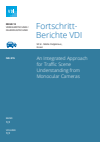Zusammenfassung
This thesis investigates methods for traffic scene perception with monocular cameras for a basic environment model in the context of automated vehicles. The developed approach is designed with special attention to the computational limitations present in practical systems. For this purpose, three different scene representations are investigated. These consist of the prevalent road topology as the global scene context, the drivable road area and the detection and spatial reconstruction of other road users. An approach is developed that allows for the simultaneous perception of all environment representations based on a multi-task convolutional neural network. The obtained results demonstrate the efficiency of the multi-task approach. In particular, the effects of shareable image features for the perception of the individual scene representations were found to improve the computational performance.
Contents
Nomenclature VII
1 Introduction 1
1.1 Motivation . . . . . . . . . . . . . . . . . . . . . . . . . . . . . . . . . . . . 1
1.2 Outline and contributions . . . . . . . . . . . . . . . . . . . . . . . . . . . 5
2 Related Work and Fundamental Background 8
2.1 Advances in CNN...
Schlagworte
Szenenverständnis – Umfeldrepräsentation – 3D Rekonstruktion – tiefe neuronale Netze – Multi-task Lernen – geteilte Bildmerkmale – eingebettete Bildverarbeitung – Fortschrittliche Fahrerassistenzsysteme – Automatisiertes Fahren Scene Understanding – Environment Representation – 3D Reconstruction – Convolutional Neural Networks – Multi-task Learning – Feature Sharing – Embedded Computer Vision – Advanced Driver Assistance Systems – Automated Driving- Kapitel Ausklappen | EinklappenSeiten
- 100–114 A Appendix 100–114
- 115–142 Bibliography 115–142

